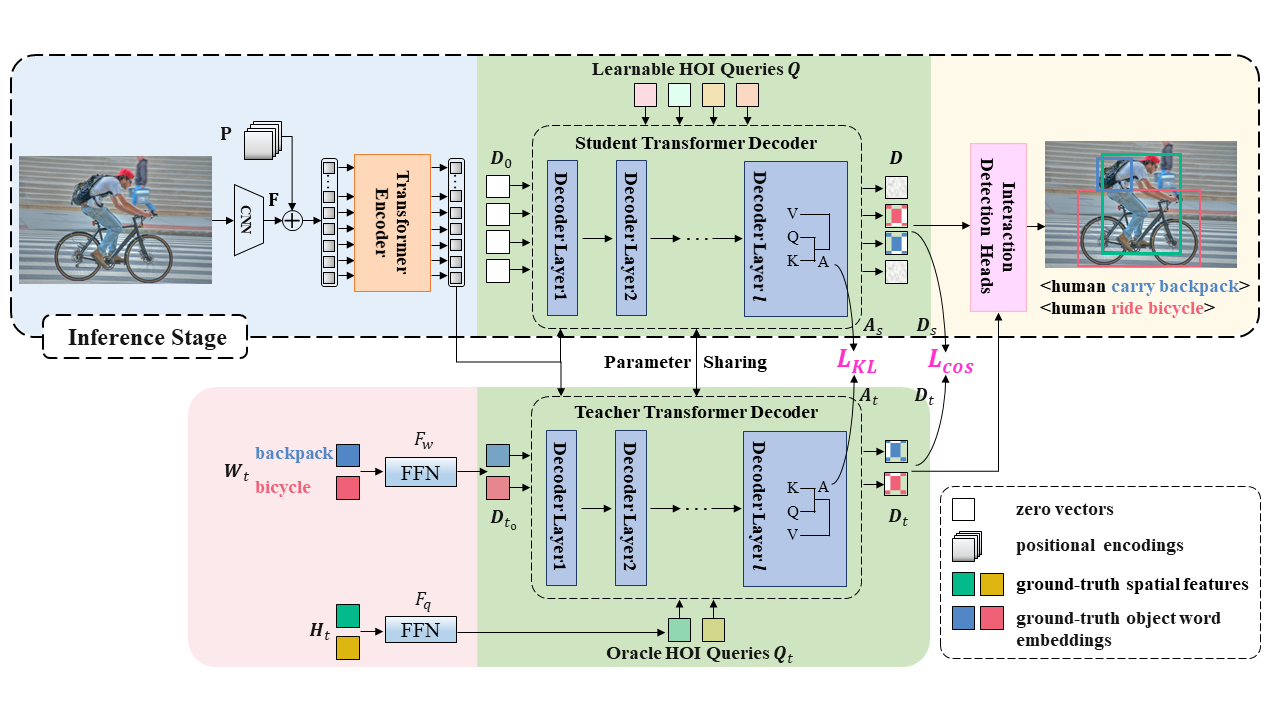Xian Qu, Changxing Ding, Xingao Li, Xubin Zhong, Dacheng Tao
The paper is accepted to CVPR2022.
## PreparationOur implementation uses environment the same as QPIC, please follow QPIC to set up pytorch environment.
The dataset structure is:
qpic
|─ data
| └─ hico_20160224_det
| |─ annotations
| | |─ trainval_hico.json
| | |─ test_hico.json
| | |─ sim_index_hico.pickle
| | |─ coco_clipvec.npy
| | └─ corre_hico.npy
| |─ images
| | |─ test2015
| | └─ train2015
| └─ v-coco
| |─ annotations
| | |─ trainval_vcoco.json
| | |─ test_vcoco.json
| | |─ corre_vcoco.npy
| | |─ vcoco_test.json
| | |─ instances_vcoco_all_2014.json
| | |─ sim_index_vcoco.pickle
| | |─ vcoco_clip.npy
| | └─ vcoco_test.ids
| |─ images
| | |─ train2014
| | └─ val2014
| └─ hoia
| |─ annotations
| | |─ test_2019.json
| | |─ train_2019.json
| | |─ obj_clipvec.npy
| | |─ sim_index_hoia.pickle
| | └─ corre_hoia.npy
| |─ images
| | |─ test
| | └─ trainval
The annotations file, pre-trained weights and trained parameters can be downloaded here
Please download the images at the official website for the datasets above.
After the preparation, you can start the training with the following command.
For the HICO-DET training.
python -m torch.distributed.launch \
--nproc_per_node=8 \
--use_env \
main.py \
--pretrained params/detr-r50-pre.pth \
--hoi \
--dataset_file hico \
--hoi_path data/hico_20160224_det \
--num_obj_classes 80 \
--num_verb_classes 117 \
--backbone resnet50 \
--set_cost_bbox 2.5 \
--set_cost_giou 1 \
--bbox_loss_coef 2.5 \
--giou_loss_coef 1 \
--output_dir outputs/hico/ts_model/ \
--model_name hoi_ts \
--epochs 80 \
--lr_drop 60
For the V-COCO training.
python -m torch.distributed.launch \
--nproc_per_node=8 \
--use_env \
main.py \
--pretrained params/detr-r50-pre-vcoco.pth \
--hoi \
--dataset_file vcoco \
--hoi_path data/v-coco \
--num_obj_classes 81 \
--num_verb_classes 29 \
--backbone resnet50 \
--set_cost_bbox 2.5 \
--set_cost_giou 1 \
--bbox_loss_coef 2.5 \
--giou_loss_coef 1 \
--output_dir outputs/vcoco/ts_model/ \
--model_name hoi_ts \
--epochs 80 \
--lr_drop 60
For the HOI-A training.
python -m torch.distributed.launch \
--nproc_per_node=8 \
--use_env \
main.py \
--pretrained params/detr-r50-pre-hoia.pth \
--hoi \
--dataset_file hoia \
--hoi_path data/hoia/ \
--num_obj_classes 11 \
--num_verb_classes 10 \
--backbone resnet50 \
--set_cost_bbox 2.5 \
--set_cost_giou 1 \
--bbox_loss_coef 2.5 \
--giou_loss_coef 1 \
--output_dir outputs/hoia/ts_model/ \
--model_name hoi_ts \
--epochs 80 \
--lr_drop 60
The evaluation is conducted at the end of each epoch during the training. The results are written in outputs/log.txt like below:
You can also conduct the evaluation with trained parameters as follows.
HICO-DET
python -m torch.distributed.launch \
--nproc_per_node=8 \
--use_env \
main.py \
--pretrained params/detr-r50-pre.pth \
--hoi \
--dataset_file hico \
--hoi_path data/hico_20160224_det \
--num_obj_classes 80 \
--num_verb_classes 117 \
--backbone resnet50 \
--set_cost_bbox 2.5 \
--set_cost_giou 1 \
--bbox_loss_coef 2.5 \
--giou_loss_coef 1 \
--output_dir outputs/hico/ts_model/ \
--model_name hoi_ts \
--resume outputs/hico/ts_model/checkpoint.pth \
--eval \
--no_aux_loss
HOI-A
python -m torch.distributed.launch \
--nproc_per_node=8 \
--use_env \
main.py \
--pretrained params/detr-r50-pre-hoia.pth \
--hoi \
--dataset_file hoia \
--hoi_path data/hoia/ \
--num_obj_classes 11 \
--num_verb_classes 10 \
--backbone resnet50 \
--set_cost_bbox 2.5 \
--set_cost_giou 1 \
--bbox_loss_coef 2.5 \
--giou_loss_coef 1 \
--output_dir outputs/hoia/ts_model/ \
--model_name hoi_ts \
--resume outputs/hoia/ts_model/checkpoint.pth \
--eval \
--no_aux_loss
For the official evaluation of V-COCO, a pickle file of detection results have to be generated. You can generate the file as follows.
python generate_vcoco_official.py \
--param_path outputs/vcoco/ts_model/checkpoint.pth \
--save_path vcoco.pickle \
--hoi_path data/v-coco \
--model_name hoi_ts_qpos_eobj_kl
HICO-DET.
| Full (D) | Rare (D) | Non-rare (D) | Full(KO) | Rare (KO) | Non-rare (KO) | |
|---|---|---|---|---|---|---|
| ours (HOTR) | 25.97 | 26.09 | 25.93 | 28.23 | 28.22 | 33.93 |
| ours (QPIC) | 31.55 | 26.75 | 32.99 | 34.15 | 29.62 | 35.50 |
| ours (CDN-S) | 33.28 | 29.19 | 34.50 | 36.11 | 31.61 | 37.45 |
D: Default, KO: Known object
V-COCO.
| Scenario 1 | |
|---|---|
| ours (ResNet50) | 63.5 |
HOI-A.
| mAP | |
|---|---|
| ours (ResNet50) | 76.87 |
Please consider citing our paper if it helps your research.
@InProceedings{Qu_2022_CVPR,
author = {Qu, Xian and Ding, Changxing and Li, Xingao and Zhong, Xubin and Tao, Dacheng},
title = {Distillation Using Oracle Queries for Transformer-Based Human-Object Interaction Detection},
booktitle = {Proceedings of the IEEE/CVF Conference on Computer Vision and Pattern Recognition (CVPR)},
month = {June},
year = {2022},
pages = {19558-19567}
}
